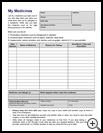
Antibiotic Medicines
________________________________________________________________________
KEY POINTS
- Antibiotics are medicines used to treat infections caused by bacteria.
- Have your child take the antibiotic medicines for as long as your child’s healthcare provider prescribes, even if your child feels better.
- Ask your healthcare provider or pharmacist for more information about your child’s medicines.
________________________________________________________________________
What are antibiotic medicines used for?
Antibiotic medicines are used to treat infections caused by bacteria such as:
- Strep throat
- Sinus infection
- Pneumonia
- Urinary tract infection
Antifungal and antiparasitic medicines can also be used to treat infections caused by fungi and certain parasites. Antibiotic medicines are not used to treat viruses. For example, they will not treat colds, flu, or most coughs and bronchitis. If a virus is making you sick, taking antibiotic medicine may do more harm than good. Never take antibiotic medicine without a prescription.
Antibiotic medicines come in different forms such as liquids, pills, shots, drops, ointments, and gels. Some antibiotic medicines need to be given through an IV either in the hospital or at home.
How do they work?
Antibiotic medicines treat infections by killing bacteria or stopping their growth. Once bacterial growth is stopped, the body's normal defenses can usually kill the bacteria.
There are many types of antibiotic medicines. Each works a little differently. Some are for specific types of bacteria. Your child’s healthcare provider will prescribe the antibiotic medicine that is best for your child’s infection. Your child may need more than 1 type of antibiotic medicine for some infections.
What else do I need to know about this medicine?
- Taking antibiotic medicines when your child doesn’t need them can cause problems. Bacteria can change and become resistant to antibiotic medicines. This means that an antibiotic medicine may no longer be able to kill the bacteria. There are now some bacteria that are resistant to all known antibiotic medicines.
- Follow the directions that come with your child’s medicine, including information about foods and drinks. Ask for written information to take home. Tell your healthcare provider or pharmacist if you need information in a different language or larger type.
- Make sure you know how and when your child should take the medicine. Do not give more or less than your child is supposed to take.
- Make sure your child takes antibiotic medicine for as long as your child’s healthcare provider prescribes, even if your child feels better. If your child stops taking the medicine too soon, it may not kill all of the bacteria and your child may get sick again. Never save antibiotic medicines for future use, and never use leftover antibiotic medicine.
- Many medicines have side effects. A side effect is a symptom or problem that is caused by the medicine. Ask your healthcare provider or pharmacist what side effects the medicine may cause and what you should do if your child has side effects.
- For liquid medicines, use the dosage device that comes with the medicine such as a dropper, syringe, or dosing cup. A different device, or a kitchen spoon, could hold the wrong amount of medicine.
- Store medicines in their original container, and out of reach of young children.
- Try to get all your child’s prescriptions filled at the same place. Your pharmacist can help make sure that all of your child’s medicines are safe to take together.
- Keep a list of your child’s medicines with you. Tell your child's healthcare provider and pharmacist about all the prescription and nonprescription medicines, natural remedies, vitamins, and supplements your child takes.
If you have any questions, ask your healthcare provider or pharmacist for more information. Be sure to keep all appointments for provider visits or tests.
Last modified: 2022-01-03
Last reviewed: 2019-06-11

